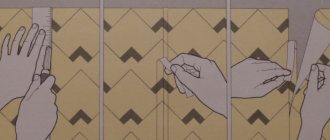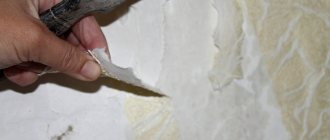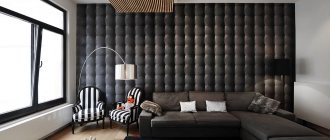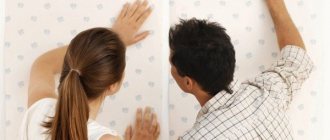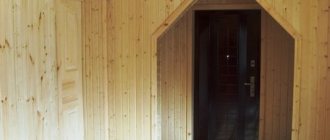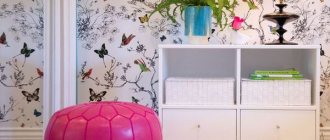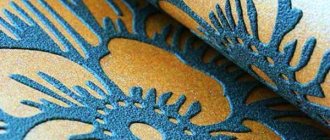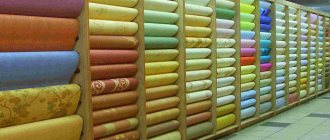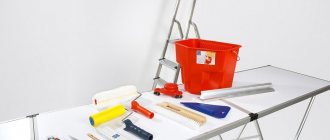So, let’s try to figure out what washable wallpaper is, what types of wallpaper exist in nature, in what rooms they are used, and how to properly and efficiently cover our walls with them.
Peculiarities
The modern consumer has an excellent opportunity to choose the most suitable finishing material to use during renovation work in residential premises.
A type of such material is washable wallpaper on a paper basis with a waterproof surface, which is easy to wash and clean from dark stains resulting from accumulated everyday dust, dirt and fingerprints.
Cleaning your wallpaper regularly is key to keeping it looking great for a number of years.
Washable wallpaper is a decorative finishing material , the cleaning of which is carried out with a damp cloth or sponge with ordinary clean water and a mild soap solution, without causing negative consequences for the wallpaper.
Washable wallpaper consists of a paper and decorative base . In most cases, such wallpaper is used to decorate the walls of the kitchen, hallway, hallway, bathroom, toilet, where there is at least some possibility of contamination.
What types of washable wallpaper are there? The following categories are distinguished:
- moisture resistant;
- washable;
- cleaning.
Caring for washable wallpaper
The presence of washable wallpaper in the house does not mean that it is necessary to carry out wet cleaning and regularly wipe the walls. You should resort to washing only when the contamination cannot be removed in any other way. No matter how wear-resistant the wallpaper is, it will not withstand constant wet cleaning.
If you still want to wipe the wallpaper, first try it in an inconspicuous place to evaluate the effect. If there are no stains or stains left, then you can safely start cleaning.
It is best to wipe the surface with a damp sponge or rag; excess water can adversely affect the material and lead to the fabric peeling off. In addition, after such cleaning, the wallpaper will take a long time to dry, and stains and smudges may remain on it.
Add to bookmarks
Advantages and disadvantages
Resistance to mechanical stress, reliability and durability are the main advantages of wallpaper of the above type.
They are characterized by their versatility , have a beautiful appearance and quite often resemble ceramic tiles in their design, which plays an important role in the interior of the room, as well as in relation to the financial issue, because their cost is much lower than the required number of finishing tiles.
Thanks to its stylish and original design, a variety of colors and patterns, these wallpapers decorate the design of the room. The glossy film that covers these wallpapers ensures their high durability.
Washable wallpaper inhibits the “breathing” of the walls, so it is not recommended to use them in living rooms.
One of the disadvantages of washable wallpaper for bathrooms is its damage under the influence of humidity and steam. Therefore, you need to use washable wallpaper wisely in bathrooms.
However, for the bathroom, wallpaper is offered that has a special coating that prevents steam and moisture from penetrating into the fibers that form the basis of the material.
Excessive and frequent washing of wallpaper can render it unusable in a short service life.
Having weighed all the pros and cons of washable paper wallpaper, you can make the right decision - one so that the renovation will bring only pleasure and delight you with its beauty and attractiveness for a number of years.
Are you interested in reading reviews of paper wallpaper? If yes, be the first to find out the opinions of those who prefer eco-style in the interior.
Read about the possibilities and variety of options for using decorative stone in the kitchen in this article. Colorful photographs and professional advice from designers will help you decide on your own vision of the future interior.
Rules for gluing washable wallpaper
To properly hang washable wallpaper, you must follow a step-by-step process.
Preparing walls for gluing
Before gluing washable wallpaper, you must carefully prepare the surface. First of all, the old decor is removed:
- If you need to remove old wallpaper, it is recommended to first moisten it generously by wiping it with a wet cloth or spraying water from a spray bottle. After a short period of time, the glue will “limp” and the canvas can be removed very easily. Remains of paper and glue are removed with a spatula.
- Old paint is removed using special solutions; after treatment, the layer is peeled off with a spatula or scraper. The paint is also softened by firing with a gas torch, but when using this method, fire safety rules must be observed.
Then the surface is puttied and all irregularities are smoothed out. After leveling, the walls are treated with a special antifungal solution, of which there are a great variety on sale. The final stage of preparation is priming the base with a primer with a high degree of adhesion for maximum adhesion of the wallpaper to the wall.
Please note: the quality of preparation can be checked with a primitive test - a small strip of tape is glued to the primed surface and torn off with a sharp movement. If there are no fragments of plaster left on the tape, then the result can be considered positive.
Glue selection
When choosing an adhesive, you should take into account that washable wallpaper is much heavier than other types of wallpaper: the adhesive must exactly comply with the technical recommendations of the manufacturers; this information is indicated by the manufacturers on the packaging of the rolls. For vinyl wallpaper, glue of the “Super Vinyl” type is used, which ensures an easy process of combining the canvases due to good glide. Fiberglass and acrylic wallpapers are glued to special acrylic compounds, and for metallized wallpapers, dispersion adhesive with fungicidal additives is used.
Gluing process
We recommend reading: Calculating the amount of wallpaper
There are several rules for gluing washable wallpaper, if followed, the result will definitely be positive. Follow these guidelines:
- Gluing wallpaper is allowed only after the walls are completely dry.
- The sticker is applied in the direction from the windows.
- In order for the stripes to be positioned evenly, it is necessary to apply a starting vertical marking on the wall - it is most convenient to carry out this procedure using the good old plumb line.
- Washable wallpaper should be glued strictly using the “joint to joint” method - they are quite thick and when glued overlapping, the joint will be very noticeable.
- After the glue has infused and swelled, it is applied to the surfaces to be glued according to the instructions.
- The canvas is applied to the wall and smoothed with a soft sponge from the middle to the edges.
- Then, using a rubber roller, carefully remove air bubbles from under the wallpaper.
Important: when carrying out work, you must carefully ensure that the glue does not get on the outer surface. If such a problem does occur, it must be immediately washed with water and wiped with a dry soft cloth, otherwise, after drying, the glue stain will stand out against the surrounding background.
- During wallpapering and until it dries completely, you should ensure that there are no drafts in the room, otherwise the wallpaper to be pasted will come off the wall.
- Before carrying out repairs, it is advisable to dismantle the skirting boards and cover the wall to the floor. If this is problematic, then the lower edge of the strip should be adjusted to meet the baseboard.
Detailed video instructions for gluing vinyl wallpaper are given below:
Washable wallpaper should be cleaned of dirt according to the manufacturer's recommendations, which are indicated on the roll packaging - after all, different cleaning methods are allowed for each type of material. It is best to try to remove dirt using a dry method - with a brush or vacuum cleaner. If the attempt is unsuccessful, then it is better to wipe the surface with a damp, well-wrung out sponge or soft cloth. It is better to use neutral detergents that do not contain aggressive substances. It is not recommended to over-wet the material to avoid softening the glue and peeling the wallpaper.
Washable wallpaper is a modern, aesthetic, fairly durable material. If you follow the rules for pasting and further caring for them, rooms decorated with washable wallpaper will delight their owners for a long time with their ease of maintenance and stylish design.
( 87 votes, average: 4.80 out of 5)
Rubber paint: characteristics of innovative material and scope of its application
Liquid wallpaper: types, advantages, application technology
Related Posts
Glue
Before you begin the process of wallpapering a room, try to purchase an adhesive that is most suitable for your type of wallpaper.
The modern building materials market offers a wide selection of adhesives and semi-finished “just add water” mixtures, and experienced consultants will always come to the aid of those who carry out repair work in their home.
High-quality glue will ensure the same high-quality further operational period of this finishing material on a wooden, concrete or plastered surface.
Most dry adhesive mixtures are made from cellulose. For gluing washable paper wallpaper, synthetic glue or bustylate is used, since these types of glue are highly resistant to moisture.
An excellent option for this type of wallpaper is KMC-N glue, which is characterized by fire-resistant and non-toxic qualities.
Important! The prepared adhesive mixture for gluing wallpaper on walls should be stored for no more than 24 hours.
Tools and materials needed for work
Tools for wallpapering.
If you decide to glue washable wallpaper yourself, then first of all you should prepare all the necessary tools and materials. To work you will need:
- prepared work surface;
- large capacity container, maybe a bucket;
- glue brush;
- putty knife;
- sponge;
- roller;
- construction tape;
- plumb line;
- knife with a sharp blade and scissors;
- scotch;
- simple pencil.
Important! It is important to pay special attention to the choice of glue.
For each individual type of wallpaper, the appropriate adhesive composition is used. Often the instructions on the rolls will indicate which glue will work best. The adhesive should be diluted in accordance with the recommendations indicated on the packaging. If you use vinyl wallpaper, then the glue should be special and not universal. Otherwise, the canvas may have poor adhesion to the wall surface. Due to the high density of the material, the adhesive must have a reinforced formula. The adhesive must necessarily contain antibacterial substances, which provide additional protection to the material from mold and fungal formations.
Return to contents
How to glue?
Before starting work, it is necessary to prepare the finishing surface: clean the walls from dust and remove the previous wallpaper; if it was washable, then it is advisable to use a sander. You should wear goggles and a mask to protect your respiratory tract and eyes from dust.
Washable wallpaper is glued to the surface of the walls with a paper backing.
For greater reliability of their fastening, you should follow the appropriate rules, in particular: apply a sufficient amount of glue to the walls and to the wallpaper itself, glue the edges of each canvas with special care so that over time they do not swell or come off, because such a factor will spoil the appearance of the room .
Use an auxiliary tool: a roller, a brush to level the already pasted walls.
Tip: While carrying out this work, close all windows and doors to avoid drafts, so that the wallpaper does not subsequently fall off the surface.
How to remove washable wallpaper when in a few years there is a need to replace it?
You can remove old canvases from the walls using hot water: the walls need to be moistened generously with water and walked over them with a special needle roller. Within 15-20 minutes the moisture will reach the adhesive layer.
By hooking a corner of the canvas with a spatula, you can carefully separate it from the wall surface.
Tip: To remove remnants of old washable wallpaper and speed up the process of dismantling old canvases, you can use steam (iron with steamer or steam mop) together with a needle roller, especially in those stuck areas where there are islands of wallpaper that do not come off due to too much lubrication with glue.
Sticking in corners
Glue the canvas in the corners, leaving allowances slightly wider than the depth of the niche. Afterwards they are cut at the top and bottom to carefully bend the wallpaper around the corner.
Glue selection
The selection of glue is carried out taking into account the fact that washable wallpaper is heavier than regular wallpaper. Universal adhesives are not suitable; you need to take those indicated on the packaging of the rolls. Dilution is carried out strictly according to the instructions, the consumption of the product depends on the type of wallpaper.
For vinyl sheets, use products like “Super Vinyl” with good glide to make it easier to join heavy strips. An adhesive with a similar composition (VGT) is suitable for acrylics; a dispersion agent with fungicides is suitable for metallized ones.
Decorating walls with washable wallpaper is not difficult. Following the technology guarantees the strength of the connection and the durability of the coating.
How to care?
Washable wallpaper, as a modern decorative finishing material, requires simple and easy care.
How to wash washable wallpaper? It is recommended to clean contaminated areas with a damp cloth or sponge using plain clean water and a weak soap solution that does not cause negative consequences for the wallpaper.
Benefits of wallpaper for the bathroom
Should you use wallpaper in the bathroom?
When in doubt: wallpaper or ceramic tiles, choose wallpaper because it has a number of advantages that other types of material do not have, namely:
- the cost of repairs will be low. For clarity, let’s take one meter of tiles, which costs 3,100 rubles. Expensive wallpaper, designed to order, has a similar price, but the calculation is not in meters, but in rolls. Add to this the cost of glue and labor;
- with the proper approach, you can paste wallpaper yourself, but laying tiles requires considerable experience;
- wallpapers update quickly. They took off the old ones and put on new ones. This number will not work with tiles. If there is tile in the bathroom, then most likely it will not be updated in the next 5 years. This process is very labor intensive and expensive;
- The last compelling argument for choosing wallpaper is that their range of colors and textures is much wider than that of ceramic tiles.
Black stylish wallpaper in the bathroom
If you decide to wallpaper your bathroom, choose high-quality models

